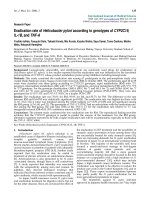Báo cáo y học: "Laboratory diagnosis of Toxoplasma gondii infection"
Bạn đang xem bản rút gọn của tài liệu. Xem và tải ngay bản đầy đủ của tài liệu tại đây (303.02 KB, 2 trang )
Int. J. Med. Sci. 2009, 6
135
I
I
n
n
t
t
e
e
r
r
n
n
a
a
t
t
i
i
o
o
n
n
a
a
l
l
J
J
o
o
u
u
r
r
n
n
a
a
l
l
o
o
f
f
M
M
e
e
d
d
i
i
c
c
a
a
l
l
S
S
c
c
i
i
e
e
n
n
c
c
e
e
s
s
2009; 6(3):135-136
© Ivyspring International Publisher. All rights reserved
Short Communication
Laboratory diagnosis of Toxoplasma gondii infection
A. Calderaro, S. Peruzzi, G. Piccolo, C. Gorrini, S. Montecchini, S. Rossi, C. Chezzi, G. Dettori
Department of Pathology and Laboratory Medicine,Section of Microbiology, University of Parma, Parma (Italy)
Published: 2009.03.19
Toxoplasma gondii is an obligate intracellular
protozoan responsible for infections throughout the
world in a wide range of hosts including humans.
Primary infection is usually subclinical but in some
patients cervical lymphadenopathy or ocular disease
can be present [1]. Infection acquired during preg-
nancy may cause severe damage to the fetus. In im-
munocompromised patients, reactivation of latent
infection can cause life-threatening encephalitis [1]. T.
gondii infection can be diagnosed indirectly with se-
rological methods and directly by Polymerase Chain
Reaction (PCR), hybridisation, isolation, and histol-
ogy. Whereas indirect serological methods are widely
used in immunocompetent patients, definitive diag-
nosis in immunocompromised people is mostly un-
dertaken by direct detection of the parasite [1].
In our laboratory the diagnosis of infection by T.
gondii is carried out by the detection of specific
anti-Toxoplasma immunoglobulin (IgM and IgG) and
to discriminate chronic from reactivated infection IgG
avidity is also determined with VIDAS instrument
(bioMerieux, France) [2]; moreover, the diagnosis of
toxoplasmosis using bioptic tissue samples, blood,
and urine is done detecting T. gondii DNA by a
Real-Time PCR Fluorescence Resonance Energy
Transfer (FRET), targeting T. gondii 529 bp repeated
region [3]. The extraction of DNA is performed from
samples by the MagNA Pure LC instrument (Roche
Diagnostics, Mannheim, Germany), according to the
manufacturer’s specifications. For FRET PCR, we
used the LightCycler Fast-StartDNA MasterPLUS
Hybridization Probes Kit (Roche Diagnostics), as pre-
viously described [3].
During the period 2006-2008 a total of 34,603 sera
were sent to our laboratory for the diagnosis of infec-
tion by T. gondii. Specific IgM were detected in 1,287
sera (3.7%), while 33,135 sera (95.8%) were negative
and 181 (0.5%) equivocal. Specific IgG were detected
in 7,328 sera (21.2%), while 26,951 sera (77.9%) were
negative and 324 (0.9%) equivocal. Among the 34,603
samples analyzed, 88 were from ophthalmological
clinic of our University Hospital, with 43 samples
(48.9%) positive, and 1 (1.1%) equivocal for IgG, 4
samples (4.5%) positive and 1 (1.1%) equivocal for
IgM, 44 samples (50%) negative for IgG and 83 sam-
ples (94.3%) negative for IgM. In two Human Immu-
nodeficiency Virus (HIV) infected patients with IgG
positive and IgM negative for T. gondii, the use of
Real-Time FRET PCR was successfully used to diag-
nose T. gondii retinochoroiditis. For both patients se-
rological assays revealed the absence of IgM and the
presence of IgG anti-Cytomegalovirus. Antibodies
anti-Toxocara spp. were negative for one patient and
not done for the other one. In both patients eosino-
philia was not detected. The first patient presented
with a progressive deterioration of sight and conjunc-
tival hyperaemia associated with pain and at the
fundus oculi examination, the ophthalmologist found
out the presence of an active retinochoroiditis. The
second patient had a deterioration of sight associated
with the presence of a retinic scar, subjected to a bi-
opsy to define its aetiology. For both patients the de-
tection of T. gondii DNA by FRET PCR performed on a
small volume of aqueous humor (<100 μl) gave a
positive result (Figure 1), allowing to confirm the
clinical suspect of T. gondii retinochoroiditis. In con-
clusion, as already reported in the literature, amplifi-
cation of T
. gond
ii DNA is a useful tool to support or
confirm the diagnosis of toxoplasmosis in subjects
with IgG positive for T. gondii as the cause of the
retinal lesions in both aqueous humor and vitreous
fluid in humans, considering that the detection of
Int. J. Med. Sci. 2009, 6
136
local specific antibodies may only provide indirect
evidence of ocular infection [4]. Moreover, it’s im-
portant to highlight that FRET PCR is able to detect
the presence of T. gondii DNA on a small amount of
sample as it was in our experience (<100 μl) from
ocular compartment.
Figure 1: Log amplification curve of Real-time PCR FRET for the detection of T. gondii DNA in aqueous humor showing
positive result. 1 = T. gondii DNA positive control; 2, 3 = patient sample (aqueous humor) tested in duplicate.
References
1. Montoya J.G.,. Liesenfeld O. Toxoplasmosis. The Lancet. 2004; 363:1965-1976.
2. Calderaro A., Piccolo G., Peruzzi S., Gorrini C., Chezzi C., Dettori G. Evaluation of Toxoplasma gondii Immunoglobulin G (IgG) and IgM
Assays Incorporating the New Vidia Analyzer System. Clin. Vaccine Immunol. 2008; 15:1076–1079.
3. Calderaro A., Piccolo G., Gorrini C., Peruzzi S., Zerbini L., Bommezzadri S., Dettori G., Chezzi C. Comparison between two Real-time
PCR assays and a nested-PCR for the detection of Toxoplasma gondii. Acta Biomed. 2006; 77: 75-80.
4. Contini C., Seraceni S., Cultrera R., Incorvaia C., Sebastiani A., Picot S. Evaluation of a Real-time PCR-based assay using the lightcycler
system for detection of Toxoplasma gondii bradyzoite genes in blood specimens from patients with toxoplasmic retinochoroiditis. Int J
Parasitol. 2005; 35: 275–283









